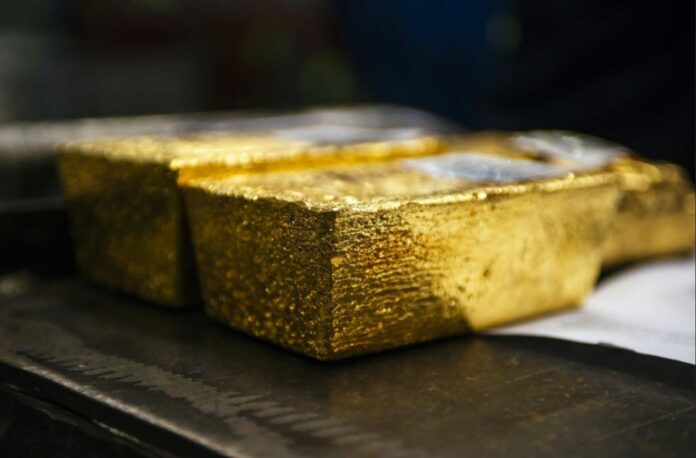A Eureka Moment for Gold: Scientists say they “can make this material using very simple ingredients in about five minutes at room temperature.”
In a groundbreaking discovery, Stanford scientists have successfully engineered a unique gold variant, termed Au2+, which lacks two negatively charged electrons. The key to keeping this unique form stable? A crystalline substance called halide perovskite is recognized for its potential in advancing technologies like solar cells, illuminating devices, and electronic components.
What’s even more striking is the ease and speed with which this Au2+ perovskite can be produced, using readily available components at ambient conditions.
Hemamala Karunadasa, a distinguished chemistry professor at Stanford and senior author of the study published in Nature Chemistry, expressed, “It was a real surprise that we were able to synthesize a stable material containing Au2+—I didn’t even believe it at first.
“Creating this first-of-its-kind Au2+ perovskite is exciting. The gold atoms in the perovskite bear strong similarities to the copper atoms in high-temperature superconductors, and heavy atoms with unpaired electrons, like Au2+, show cool magnetic effects not seen in lighter atoms.”
Kurt Lindquist, who spearheaded the study during his Ph.D. at Stanford and currently continues his research at Princeton University, highlighted the potential of halide perovskites.
“Halide perovskites possess really attractive properties for many everyday applications, so we’ve been looking to expand this family of materials. An unprecedented Au2+ perovskite could open some intriguing new avenues.”
The Unique Electron Dynamics in Gold
Gold, as a metal, is cherished not just for its rarity but also for its exceptional pliability and its chemical stability. This means it can effortlessly be molded into ornaments or coins without the fear of reacting with environmental elements and losing their luster. One of gold’s standout traits is its deep, signature color, unparalleled by any metal in its unadulterated form.
Delving into the physics of gold’s iconic hue reveals why the Au2+ state is an oddity, as described by Karunadasa.
This all ties back to the theories of relativistic effects, pioneered by none other than the legendary Albert Einstein in his theory of relativity. As Karunadasa interprets Einstein’s teachings, “When objects move very fast and their velocity approaches a significant fraction of the speed of light, the objects get heavier.”
This principle isn’t just for macro objects but also holds for atomic particles, especially for weighty elements like gold, which have a nucleus brimming with protons. Due to this, there’s a powerful positive charge pulling the negatively charged electrons, making them orbit the nucleus at incredibly high velocities.
This makes the electrons ‘heavier’ and they cluster closely around the nucleus, altering their usual positioning. As a result, gold tends to absorb blue light, presenting us with its distinctive yellowish appearance.
Furthermore, because of this electron configuration influenced by relativistic effects, gold predominantly appears as either Au1+ or Au3+, with the removal of one or three electrons, respectively. The elusive Au2+ state, indicating the loss of two electrons, is generally overlooked. Notably, the term “Au” for gold is derived from the Latin word “aurum.”
The Curious Case of Vitamin C and Gold
Stanford scientists discovered that under the right chemical arrangement, the elusive Au2+ can be stabilized. While Lindquist was engrossed in a larger study on magnetic semiconductors aimed at electronics, he accidentally identified this unique Au2+-containing perovskite.
In an experimental setup, Lindquist blended a salt, namely cesium chloride, with Au3+-chloride in water. To this mixture, he introduced hydrochloric acid, and intriguingly, a dash of vitamin C. In the resultant chemical reaction, vitamin C, acting as an acid, passed on its electron to Au3+, transforming it into Au2+. Notably, this Au2+ form remained stable within the solid-state perovskite but not when dissolved.
“In the lab, we can make this material using very simple ingredients in about five minutes at room temperature,” Lindquist remarked. “We end up with a powder that’s very dark green, nearly black, and is surprisingly heavy because of the gold it contains.”
Realizing the potential significance of their discovery, Lindquist proceeded with thorough examinations of the perovskite, deploying methods like spectroscopy and X-ray diffraction to discern its light absorption properties and crystal configuration. Collaborations with Stanford teams led by experts like Young Lee and Edward Solomon further enhanced the understanding of Au2+’s behavior.
This study not only affirmed Au2+’s existence in perovskite but also serendipitously connected to the legendary chemist Linus Pauling’s work. Renowned for bagging the Nobel Prize in Chemistry in 1954 and the Nobel Peace Prize in 1962, Pauling had, in the early stages of his career, explored gold perovskites of Au1+ and Au3+ forms. Interestingly, Pauling had also researched vitamin C’s structure, a vital component for achieving the stable Au2+ perovskite.
Karunadasa mentioned, “We love Linus Pauling’s connection to our work. The synthesis of this perovskite makes for a good story.”
Eager to delve deeper, the team, including Karunadasa and Lindquist, intends to further analyze this novel material and refine its chemical attributes. They anticipate that the Au2+ perovskite could revolutionize fields necessitating magnetism and conductivity, particularly with the electron transition between Au2+ and Au3+ states.
Karunadasa concluded, “We’re excited to explore what an Au2+ perovskite could do.”
Image Credit:
